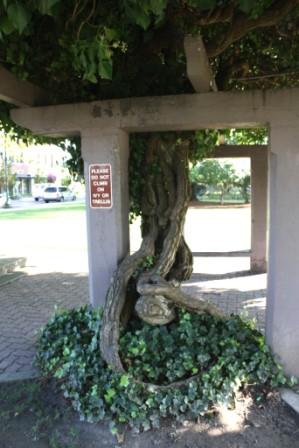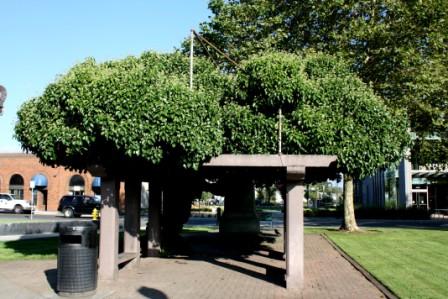One of my colleagues emailed me a couple of pictures last week taken in Puyallup, WA. As you can see, there’s a trellis supporting a massive old trunk…

…and crown…

of an ancient Hedera helix ‘Baltica,’ a cultivar of English ivy.
For those of you not in Washington or Oregon state, English ivy is a designated noxious weed. Thousands of dollars and hours of labor are spent on removing this species from forested areas in Washington state, where it crowds out native species and increases tree failure simply through the weight of vegetation. It is not a well-mannered ornamental in our climate.
So why, you may ask, is this particular English ivy prominently displayed and obviously cultivated? Chris Pfeiffer (my colleague) found out that it had been planted by Mrs. Ezra Meeker, wife of the founder of Puyallup, over 140 years ago at their original homestead. It is part of Puyallup’s cultural history and is considered a heritage “tree.”
But as you can see in the second photograph, the ivy is in flower and presumably will set seeds, thus contributing to the invasive problem. I don’t know enough about the City’s management plan for this specimen, but I doubt it includes removal of the flowers before seed set.
So what should communities do in situations like this? I think the city needs to remove the flowers, though this would be a labor intensive activity. But it would only take one person a few hours to hand prune the flowers.
I’ll be curious to hear what you all think, and whether you have seen similar collisions between historical significance and appropriate plant choices.
This area appears to be highly groomed and well cared for. They can afford to groom it further to remove seeds. Birds can fly a long way with seeds in their gut. Just as we no longer tolerate second hand smoke, we should not tolerate second hand invasive plants.
I agree that if it’s a problem, they should prune off the flowers to keep the plant. That said, I’d love to hear a follow up from Chris on whether there is any indication that this particular plant has reseeded anywhere in the immediate area. With a seed set like that on a plant that old, shouldn’t the whole town be an ivy by now? Do they have ivy killing parties in Puyallup every year?
Paul, I work in Puyallup, and yes ivy is a noxious weed all over the city, especially in riparian areas. Ironically, the City of Puyallup has a restoration program that includes ivy removal around Meeker Creek (http://www.cityofpuyallup.org/services/development-services/puyallups-stormwater-management-program/water-resources/) – and yes, it’s named after the same Meeker that planted, in all likelihood, the first English ivy in Puyallup. Whether new seedlings are from that particular plant, who knows? There’s also English ivy in our landscape at the research center. Sigh.
I think it deserves a chainsaw. I have
a passionate hatred for this stuff. It is coming into my yard on two sides, and I am allergic to it.
No kidding? That doesn’t make any sense at all. Saving a plant in one area just to eradicate the seedlings in another adjacent area…I can’t get my head around that. What’s their justification?
Paul, you now feel my pain! (Maybe it’s job security?) I think I might have to contact the city directly to figure out their rationale. I’ll have to do an update if I figure anything out.
Aren’t there sprays to prevent fruit set (Ethelene, maybe? I don’t remember what the active ingredients are) That would be a cheap and easy way to control the problem without loosing the history.
Joseph, I was wondering that myself, since I know that Ethephon (an ethylene-producing spray) prevents olives from flowering. I don’t know if anything’s been done on ivy, however. And I’m not sure it would be easy to figure out the timing on this, or whether you’d have to do numerous sprays throughout the season. (Looks like a good research project for someone!)
Can’t some of the other commonly used growth regulators affect flower and fruit set also?
Wes, nothing’s been tested on English ivy, so who knows? Practically, there’s not much of a market for such an application, since few ivy vines are managed as specimens rather than destroyed (at least in this part of the country). Where English ivy isn’t considered a noxious weed, there probably isn’t much concern about flowering and fruiting.
As an aside, ethylene-producing compounds are the only ones that I know with direct effects on flowering and fruit set (not of ivy, necessarily, but plants in general). Paclobutrazol can affect flowering in some plants, but it’s not a PGR and actually antagonizes gibberellins.
Okay, I’ll bite, why is Paclobutrazol not a PGR? We rely heavily on Bonzi for height control of annuals and perennials. It controls height, so I’ve always considered it a PGR.
Oops, Paul, I meant to say endodenous PGRs. Ethylene’s the only endogenous one with effects on flowering and fruiting. Of course there are lots of synthetic PGRs!
Linda, I understand where your coming from on the Managed Specimen angle. I guess it’s kinda like if your the only one in your neighborhood willing to use milky spore.
Anyway, if its used on the historic specimens it can at least make them politically correct specimens? Kind of another eat your cake and have it too situation?
Wes, absolutely this specimen could be managed to be a good neighbor – but my guess is that the city’s budget will probably not cover this activity. What they probably need is some publicity about the issue. I’m going to see what I can do.
I wouldn’t want to make the decision for another community but if it were in my own community, I would probably cut it down and plant something new (and not invasive! Maybe even native!) It should definitely be a city wide discussion. I recently had to make the call on about 20 or so invasive trees in our community and as hard as it was, they got the axe or maybe I should say the basal bark treatment. The community is our main source of volunteers for removing invasive plants and were happy to see the source of seeds taken out.
Would Mrs. Ezra Meeker really want to be forever known for planting something that causes endless hours of work somewhere else?